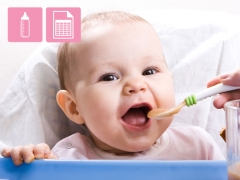Table feeding introduction for artificial feeding
The main difference in the feeding scheme for babies who are on artificial feeding is the earlier start of acquaintance with food, since the digestive tract of the artificial infant used to become familiar with products that are distinguishable from mother's milk (milk formulas). And therefore, he is more prepared to digest non-dairy products (vegetable puree and porridge). The table given in this article is also suitable for mothers who do not have enough breast milk, and there is no possibility to buy mixtures.
It is also important not to forget that the increase in the number of any meal of the complementary food should be gradual and carried out carefully. It is necessary to observe all the reactions of the child, in time to identify signs of intolerance to the product.
Products | Age (months) | ||||||
4 | 5 | 6 | 7 | 8 | 9 | 10-12 | |
Vegetable puree | From 5 g, gradually increasing to 100 g | 100-120 g | 100-120 g | 120-150 g | 150-170 g | 150-180 g | 180-200 g |
Kashi dairy-free | From 10 g, gradually increasing to 150 g | 150-180 g | 180-200 g | - | - | - | |
Fruit puree | From 5 g, gradually increasing to 30 g | 40-60 g | 60 g | 70 g | 80 g | 90-110 g | |
Vegetable oil | 1 g (about 1/5 tsp) | 3 g (about half tsp.) | 3 g (about half tsp.) | 5 g (1 tsp.) | 5 g (1 tsp.) | 6 g (a little more than 1 tsp.) | |
1 g | 3-5 g | 3-5 g | 3-5 g | 5 g | |||
Fruit Juices | From 10 ml to 30 ml | 50 ml | 60-70 ml | 80-110 ml | |||
Biscuit, crackers | 3-5 g | 5 g | 5 g | 10 g | |||
Yolk | Fourth | Half | Half | Half | |||
Cottage cheese | 10-30 g | 30-40 g | 40 g | 40-50 g | |||
Milk porridges | From 5 g, gradually increasing to 180-200 g | 180-200 g | 180-200 g | 180-200 g | |||
Bread wheat | 5 g | 5 g | 10 g | ||||
Meat mashed potatoes | 10-30 g | 30-50 g | 60-80 g | ||||
Dairy products | From 10 ml, gradually increasing to 150 ml | 150-200 ml | 150-200 ml | ||||
Fish puree | From 10 g to 50-60 g | ||||||
If a child responds to any product by changing the stool, rash or other symptoms, it should be canceled for a few weeks and then try to enter the baby’s diet again. In addition, it is not recommended to give the child several new foods on one day in order to know exactly what kind of food has a reaction to.

























































